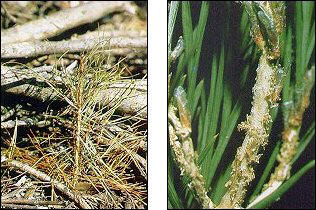Importance: Pales weevil (Hylobius pales) and pitch-eating weevil (Pachylobius picivorus) occasionally cause considerable losses to pine seedlings in Alabama. Adults commonly feed on cambium of one-year-old seedlings but will also feed on and destroy older seedlings and saplings. When there large population buildups, 50-80% of seedlings may be destroyed. These weevils are more important in Alabama as larger tracts are clearcut and planted.
Identification: Weevils are robust, hard-shelled beetles characterized by a rigid and prominent snout with tiny chewing mouthparts at the tip. Pales weevil and pitch-eating weevil are similar in appearance. Adults are black or nearly so, and often speckled with whitish markings.
They are 1/4 to 1/3 inch long. Larvae of both species are legless, approximately 1/4 inch long, and white with a dark brown head capsule. Pupae are white and the typical weevil beak is distinctive. Eggs are very small and white.
Signs of Attack: Adults typically girdle bark around and below the root collar of one-year old and older seedlings. They may also eat patches of bark anywhere on the stem and branches. Seedlings suddenly wither and die. If insects are abundant, they may remove all of the bark and foliage, leaving only yellowish, pencil-like stubs protruding from the soil. Examination of pine stumps and large roots in the area may reveal larvae, pupae or oval fibrous covered (nest-like) pupal cells.
Life Cycle: Most damage by the pales and pitch-eating weevils occurs in spring and fall. Adults are attracted to the odor of freshly cut pine stumps, scorched pines, or dying trees, and feed on tender bark of nearby seedlings. Eggs are deposited in the root bark of stumps and trees. Larvae hatch in one to two weeks, and feed primarily in roots for six to eight weeks. Larval galleries are packed with granular borings and when larvae are mature, they construct a shallow fibrous covered pupa cell in the sapwood. The pupa stage lasts two to four weeks, depending on the temperature. New adults may feed on seedlings before flying to other cutover or recently burned stands. The weevils feed at night. By day, they may be found in litter or soil near damaged seedlings.
Control: Under forest conditions, the most practical and inexpensive method of control is to delay planting recently harvested areas for 9 to 12 months. Also:
- If no pine has been cut from an area to be planted, there will be no weevil problem.
- If a pine stand is cut before June 1 and the area will be planted during the following winter, there will be no weevil problem.
- If 3 cords of pine or less are cut from an area or pushed down during site preparation after June 1, losses should be less than 5% if the area is planted during the following winter.
- If 5 to 10 cords/acre of pine are cut or pushed down during site preparation, losses may be up to 25% if the area is planted the following winter.
- If over 10 cords of pulpwood or 5,000 board feet of sawtimber are cut or pushed down during site preparation after June 1, use treated seedlings or plant seedlings next year.
Chemical Control: Forest control: Spray foliage with 0.5% malathion (mix 6 ½ pts. 57% malathion E.C. with 100 gallons of water or fuel oil; or 2 T/gal.) or 0.5% sevin (mix 5 lbs. of 80% sevin wettable powder with 100 gal. of water; or 2 T/gal.) Shade tree control: Hand pick and destroy larvae or spray with above mixture using WATER instead of fuel.
Pine weevil feeding damage

Left: girdled loblolly pine seedling; Right: twig of Scotch pine Christmas tree.
Photo Credits: Clemson University, USDA Cooperative Extension Slide Series, ForestryImages.Org ; W. H. Kearby, retired Professor of Entomology, University of Missouri.
Additional Resources